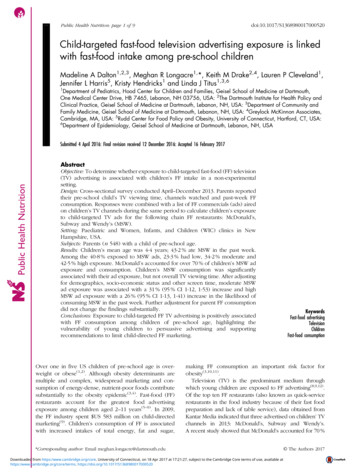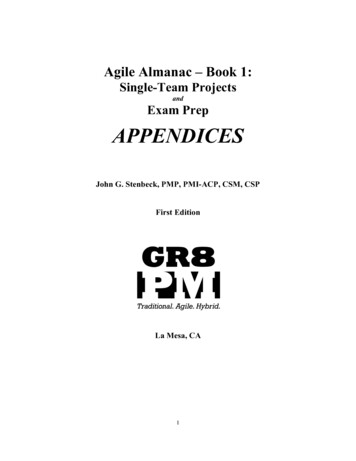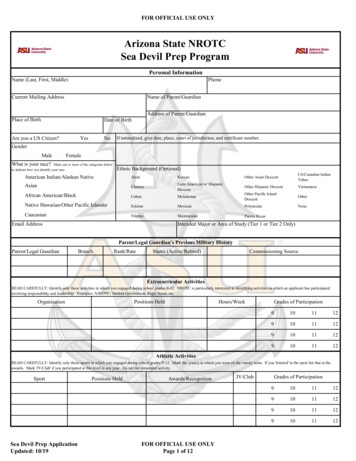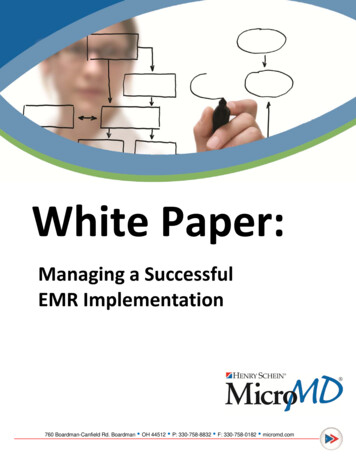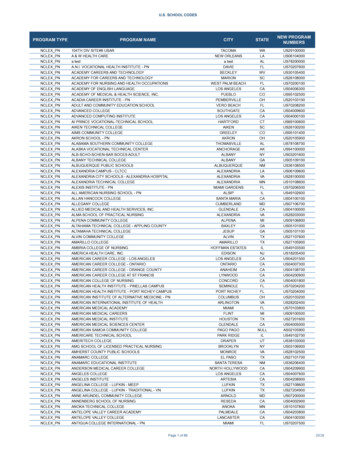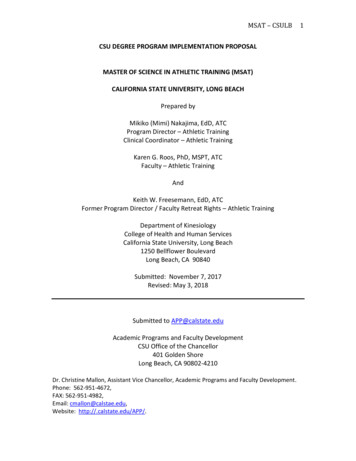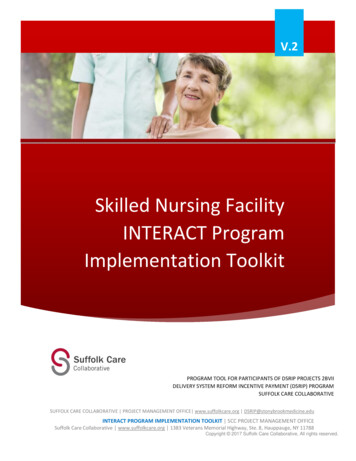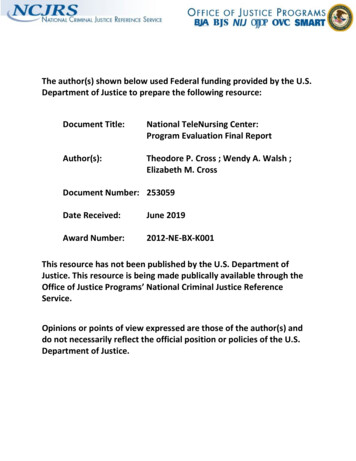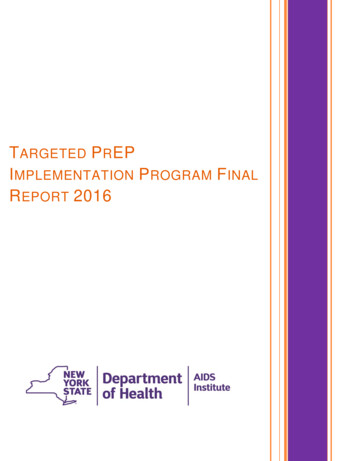
Transcription
T ARGETED P R EPI MPLEMENTATION P ROGRAM F INALR EPORT 20160
ACKNOWLEGEMENTSThe Targeted PrEP Implementation Project was made possible through the collaboration amongthe following contributors:AIDS Institute:Office of the Medical DirectorDivision of HIV/STD Epidemiology, Evaluation and Partner ServicesDivision of HIV and Hepatitis Health CareParticipating Agencies:APICHAEvergreen Health ServicesSUNY Downstate/HEAT ProgramTrillium HealthWilliam F. Ryan CHC
TABLE OF CONTENTSTargeted PrEP Implementation Program (TPIP) Final ReportPageBackground .1Program Participation .1Activities and Timeline .2Program Evaluation Activities .3Human Subjects Considerations .4Evaluation Findings .4Findings from Medical Visits .4Lessons Learned from Clients .5Lessons Learned from TPIP Providers .6Furthering PrEP Implementation by the AIDS Institute .7AppendicesA. Targeted PrEP Program - Implementation Protocol .AB. Medical Visit Forms .BC. PrEP Implementation Program Client Survey .CD. Targeted PrEP Implementation Program (TPIP) Agency “Table Talk”.DE. Data Brief #1 – Targeted PrEP Implementation Program .EF. Data Brief #2 – TPIP Clients Exit Survey .FG. Data Brief #3 – TPIP “Table Talk” .G
New York State Department of Health/AIDS InstituteTargeted PrEP Implementation ProgramFinal ReportBACKGROUNDThe efficacy of pre-exposure prophylaxis (PrEP) using Truvada as a biomedical HIV preventionintervention had already been established at the clinical trial level. The Targeted PrEPImplementation Program (TPIP) was an 18-month project designed to assess the extent towhich PrEP could be implemented in “real world” clinical settings. The goals of TPIP were toassist the AIDS Institute in identifying needed resources to enable routine use of PrEP and laythe foundation for statewide program implementation, where PrEP is delivered as part of acomprehensive prevention plan.Although PrEP was approved for several populations, it has the most potential to assist inreducing HIV transmission among gay men/men who have sex with men (MSM). Thus, adecision was made to assess the practicality of implementing TPIP in clinical settings serving asignificant number of MSM adults. Key implementation questions included: What program elements facilitate the ability of medical providers, in collaboration withcommunity-based organizations (CBOs), to successfully identify, recruit and retainappropriate candidates for PrEP? What program activities are needed to assist PrEP clients in adhering to theirmedications with sufficient rigor to adequately protect them from contracting HIV? What key program elements are needed to enable PrEP to be delivered as part of acomprehensive and integrated prevention plan that minimally includes:o regular attendance at medical appointmentso regular testing for HIV and sexually transmitted illnesses (STIs)o consistent and correct condom useo safer-sex practices and risk reduction counseling?PROGRAM PARTICIPATIONThe AIDS Institute invited five medical providers to participate in TPIP. These providers werebeing funded by the AIDS Institute for other initiatives, were already providing services to largenumbers of MSM, had strong linkages with relevant CBOs and were willing to participate inTPIP without additional funding. Three of the agencies were located in New York City: APICHA,William F. Ryan Community Health Center and the HEAT Program at SUNY-Downstate MedicalCenter. Two agencies were in upstate New York: Evergreen Health Services in Buffalo andTrillium Health in Rochester.7/28/2016
Total client enrollment in TPIP was projected to be at least 150 individuals among the 5 clinicalsites. TPIP’s client eligibility was focused on MSM and transgender women who met thefollowing criteria: male sex at birth aged 18 or older HIV-seronegative status evidenced high-risk behavior for acquisition of HIV infection willing to provide contact information informed about program requirements and willing to participate as indicated.ACTIVITIES AND TIMELINEThe five medical providers and their CBO partners were expected to work together to: utilize internal and external resources to identify potential clients for PrEP screen potential clients for eligibility and enroll eligible/willing clients in TPIP prescribe PrEP to clients provide supportive services as part of a comprehensive prevention plan that includedroutine HIV and STI testing, adherence counseling, education on condom use and safersex practices participate in twice monthly calls with the other TPIP providers and AIDS Institute staff todiscuss program activities, identify best practices and troubleshoot problems participate in data collection, monitoring and evaluation activities.Prior to initiation of TPIP, a three hour training was provided by webinar in January 2014 todiscuss the PrEP clinical guidance and TPIP protocol, including data collection.The intent was for the partnering CBOs to serve as recruitment venues for clients to participatein TPIP and provide some or all of the comprehensive HIV prevention services key to the PrEPpackage. The partnering CBOs could be either onsite or within close proximity of the medicalprovider.The recruitment period for TPIP was a 12 month period, beginning February 1, 2014 and endingJanuary 31, 2015. There was a 12-month follow-up period for clients enrolled during the first 6months and shorter follow-up period for clients enrolled in the second six months. TPIP endedon July 31, 2015, and data were collected on clients until that date.All clinically related activities (e.g., determining clinical eligibility, provision of PrEP, clinical visitschedules, assessment activities, testing for HIV and STIs, etc.) were conducted according tothe AIDS Institute’s “Guidance for the Use of Pre-Exposure Prophylaxis (PrEP) to Prevent HIVTransmission”, dated January 2014. For a summary of TPIP clinical activities and timeframes,see: “Table 1: Summary of PrEP Visits and Assessments, from Appendix A: “Targeted PrEPProgram – Implementation Protocol”.7/28/20162
PROGRAM EVALUATION ACTIVITIESThe PrEP program evaluation focused on activities necessary to assess the following generalquestions: What program elements were needed to facilitate the ability of medical providers andCBOs to successfully identify, recruit and retain appropriate clients for PrEP? What program activities were needed to assist PrEP clients in adhering to theirmedication with sufficient rigor to adequately protect them from contracting HIV? What key program elements were needed to enable PrEP to be delivered as part of acomprehensive prevention plan which minimally includes:o consistent and correct condom useo safer-sex practices and risk-reduction counselingo HIV testing and screening for other STIs that can facilitate transmission?Specific questions that were assessed during TPIP included: What percent of recruited clients were deemed eligible and agreed to participate? What percent of providers were able to recruit the targeted number of PrEP clients? What program activities assisted providers in recruiting PrEP clients? What percent of clients were adherent enough to their medication to remain on PrEP,and what program activities assisted them in doing so? What percent of clients dropped out of the program and for what reasons (such as:seroconversion, lack of adherence, medical indications, self-removal, lost to follow-up,other reason)? What percent of clients completed the 12-month program period? What were the most effective prevention messages and interventions to assist withbehavior change?o Did the self-reported risk behaviors of clients change during the program and, ifso, how?o What percent of clients tested positive for STIs during the program period?o What percent of clients reported condom use and did this change during theprogram?Data were collected using several methods: Medical Visit Forms: Providers completed one of two forms at each medical visit: 1)PrEP Client Intake and Eligibility Form (completed at the initial baseline medical visit andthe follow-up visit at 2-4 days) and 2) PrEP Client Medical Visit Form (completed at allother medical visits). The client’s ID number on the data collection forms was their AIRSTc Id number. See Appendix B: medical visit forms. AIDS Institute Reporting System (AIRS): In addition to these brief data collection forms,demographic and key service-related information (such as HIV testing and STIassessment/testing) was entered directly into AIRS by the provider. Client Exit Surveys: All clients were asked to complete a Client Exit Survey afterparticipating in TPIP for 12 months or, if the client had not completed a full year in TPIP,at the end of TPIP which was July 31, 2015. The client exit survey captured:o clients’ experiences while being on PrEPo insurance issues experienced by clientso program activities that assisted PrEP adherenceo clients’ ratings of key program elements.7/28/20163
See Appendix C: “The PrEP Implementation Program Client Survey”. Agency “Table TalK”: This was a guided discussions by each participating agencyamong their own TPIP staff to:o reflect on their partnership with the AIDS Institute in promoting and implementingPrEPo share best practices and challenges they facedo provide recommendations for future program implementation.See Appendix D: “Targeted PrEP Implementation Program (TPIP) Agency ‘Table Talk’”.HUMAN SUBJECTS CONSIDERATIONSThe NYS Department of Health’s Institutional Review Board (IRB) reviewed the project’s protocoland determined that it represented program evaluation and therefore did not constitute “research”and was not subject to IRB review. All clients were fully informed about the program and agreedto participate. Data associated with the program were reported to the AIDS Institute in a deidentified manner, using a unique ID linkable back to clients only at the provider level.EVALUATION FINDINGSOne hundred ninety-eight (198) individuals were assessed for TPIP, of which 27 (13.6%) did notmeet TPIP’s eligibility criteria. One hundred seventy-one (171) clients met TPIP’s eligibility criteriaand were enrolled in the program. Thus, total enrollment exceeded the projected target of 150clients.Findings from Medical Visits:For the 27 clients who did not meet TPIP’s eligibility, the most frequently reported reasons were:tested HIV-positive at baseline, had acute HIV at assessment, were less than 60 days aftercompleting a PEP regimen, or had insurance issues.Among the 171 clients enrolled in TPIP, the majority were white (60.2%), aged 25-34 years(46.2%), male (93.6%) and privately insured (66.7%). Clients reported good adherence withtaking Truvada; from 91.0% to 94.1% of the clients during the program reported taking 4 ormore doses the week prior to their medical visits. Clients with unstable housing were more likelyto miss at least one dose of PrEP in the week prior to their medical visit (OR 4.72, 95% CI (1.33-16.7).Side effects from Truvada were reported among a small group of clients, and diminished overtime. The side effects clients reported at their first medical visit after starting Truvada weregastrointestinal problems (21.8%), fatigue/drowsiness (5.9%), headaches (2.4%) and loss ofappetite (1.8%).7/28/20164
HIV testing was conducted at each 3-month medical visit. None of the clients who had been onPrEP for any significant length of time acquired HIV infection during the program. One client,HIV-negative on his initial assessment, tested positive at one month. This client likely was in thewindow period at the time of his initial assessment, which was not identified by HIV testing doneat that time.Clients were tested for STIs at enrollment into TPIP and at their 6 and 12 month medical visits.Screening for STIs was conducted at other medical visits, and testing was done if indicated bythe screening. Overall, 13 clients (7.6%) had at least one STI at baseline. Few new positive STIcases were identified during the follow-up.Among the 171 clients enrolled in TPIP, 41 (24.0%) clients discontinued PrEP before TPIP wasconcluded. The most frequently reported reason for discontinuing PrEP was client’s request tostop due to changes in behavior. The majority of clients who discontinued PrEP did so within thefirst 6 months.See Appendix E: “Data Brief #1 – Targeted PrEP Implementation Program” for additional dataobtained from the medical visit forms.Lessons Learned from Clients:TPIP clients were asked to complete a client exit survey at the end of their participation in theprogram. The client exit survey captured their experiences while being on PrEP, issues theyencountered while in TPIP and program activities that helped them remain in the program.Eighty-three clients completed the survey. The majority of survey respondents had positivecomments about their experiences with TPIP.The majority of survey respondents found it easy to attend medical visits every three months,regularly test for HIV and STIs, take a pill every day and manage any side effects experienced.They also reported that, since being on PrEP, they had no change in
The AIDS Institute invited five medical providers to participate in TPIP. These providers were being funded by the AIDS Institute for other initiatives, were already providing services to large numbers of MSM, had strong linkages with relevant CBOs and were willing to participate in TPIP without additional funding. Three of the agencies were located in New York City: APICHA, William F. Ryan .

